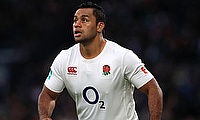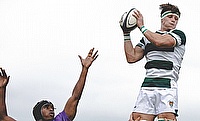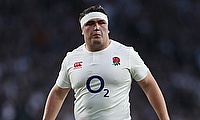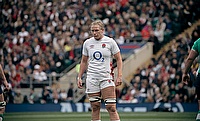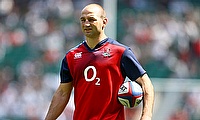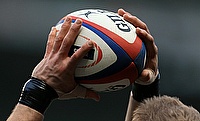‘He understands the tackle height stuff’ – England defence coach Kevin Sinfield on Owen Farrell
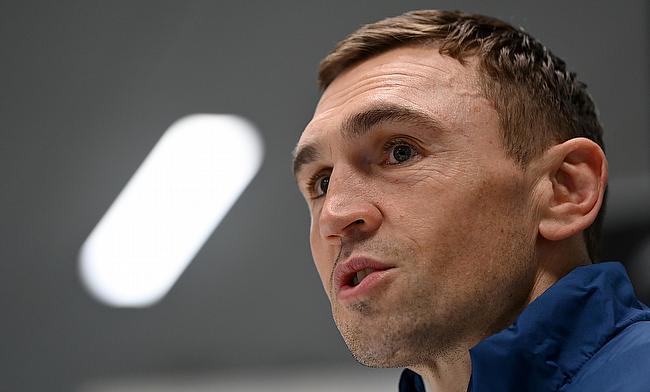
Steve Borthwick said that Sinfield's coaching on tackling is the framework for World Rugby's Coaching Intervention Panel
©RFU Collection via Getty Images
Defence coach Kevin Sinfield says that England captain, Owen Farrell “understands tackle height stuff” with the fly-half currently serving a ban for a high shot against Gloucester in the Gallagher Premiership.
Speaking at Twickenham Stadium on Monday, the coach who followed head coach Steve Borthwick from Leicester Tigers to the England setup, Sinfield was credited by Borthwick for the establishment of World Rugby’s Coaching Intervention Panel, which Owen Farrell is currently in the process of completing following his citing for a tackle.
Ultimately scoring the winning drop goal at Kingsholm that afternoon in early January, the 31-year-old escaped missing the Guinness Six Nations thanks to being able to take part in the so-called “tackle school” which reduces a players ban.
Educating players and improving their tackle technique, the initiative was introduced in 2021 and with the aim of reducing injury risk and, in turn, the number of red cards.
Over the most recent round of Heineken Champions Cup action, five red cards were dished out across the weekend, including one for England’s Henry Slade against the Vodacom Bulls in Pretoria.
After having been grilled throughout the morning about Farrell and his tackle technique, after announcing the Saracens man as his captain along with his first England squad selection, when asked why tackling will not be an issue in the future, Borthwick put his assistant coach front and centre.
“I think the coaching intervention programme came about a year ago,” Borthwick said. “The model they use is Kev’s coaching. World Rugby are now using it as an example of how to run the course.
“We want a team that is physical and fights, but we want to play fair. We want 15 players on the pitch. We accept we’re not going to be able to change habits overnight, but we’re going to start trying to change them overnight.”
So, roughly 30 minutes later when Sinfield sat at the head of the table, you can imagine what the topic of conversation was. In his opening statements on the press conference streamed by England Rugby, Sinfield spoke about a conversation he and Borthwick had some 18 months ago about tackle height in his kitchen in Oldham.
Joking that the pair had not been running against each other, the former Leeds Rhinos Director of Rugby spoke about tackle height having been a key focus for him while coaching Leicester Tigers to a Gallagher Premiership title in 2022.
“Anyone who worked with me at Leicester Tigers will know how hard we went after tackle height,” Sinfield said in his opening statement. “We want kids around the country to pick rugby calls up, boys and girls, to play our sport. We want parents to be happy that their kids are playing, so we absolutely support the safety measures.
“I think for the pair of us, and the coaching team, we believe it’s the best way to tackle. We will work hard right from day one on tackle height within our squad. We are not shying away from the fact, the game has to change.
“Our elite players will need to make some adjustments, but we do understand well, the pair of us, that we will make mistakes along the way, as will the players. How we handle that is going to be really, really important. But we will work incredibly hard at it.”
Following Farrell’s citing and subsequent ban, Sinfield had dinner with the England captain. Saying that tackle height and technique had very little to do with their conversation, Sinfield largely noted how “desperate” Farrell was to play for England after that meeting with the 100-cap back.
“The main thing I took away was how desperate he is to play for England,” Sinfield said. “How excited he is to play for England.
“I think I mentioned to you guys in Gloucester, the glint in people’s eyes, the excitement of what 2023 has to offer. The excitement of this first game. The excitement about a new squad and a new regime.
“I don’t know how much media and press he [Farrell] does, but he’s genuinely so excited to play for his country. At that point, I’d probably say a lot of the squad had been put together. But I came away knowing that Owen is in a really good place.
“He understands the tackle height stuff. He’s been smacked over the head with that enough now. I think it’s quite refreshing that we’ve got a 10 who wants to put his body on the line and wants to be physical.
“I think it’s a great message for our younger players around the country. He wants to tackle. The challenge for us – and across the squad – is to ensure that we don’t cross that line.”
It was after Ollie Chessum’s red card at Mattioli Woods Welford Road in a Champions Cup Round of 16 game against Clermont which Borthwick anointed as the establishment of World Rugby’s framework for tackle school.
Dismissed in the 63rd minute of that game for a high shot on Samuel Ezeala, the England international had failed to dip low enough into the tackle and received a three-week ban in the days that followed, the work Sinfield did behind the scenes in Steve Borthwick’s mind paving the way for the Coaching Intervention Panel.
“He [Chessum] got sent off for a tackle against Clermont at home,” Sinfield said. It was basically about getting an understanding of how and why the tackle happened, the body position he was in and then understanding the ramifications of getting it wrong, not only for his opposite number but himself.
“The safety measured are the priority, but secondly, it’s about the damage it does to the team. In club rugby, it’s really difficult to win with 14 men and Test rugby is a step up. We need all out players on the field at all times. So the priority is the players’ safety, but number two is that we need 15 players on the field at all times.
“You go through a series of drills, starting very basic then you build them up so you almost replicate the tackle that they got sent off for. It’s about having an understanding as you work your way through the process; how you got there and how you’re going to try to avoid it.
“If you had come into Leicester at any point, we were working on tackle height. We did so much on it anyway, right from that first conversation with Steve, or the second conversation in my kitchen.
“I knew it would be an issue, especially when you have got such a difference in the height of players – guys who are 6ft 10in up against guys who are 5ft 8in. it’s an inevitable issue so it’s something we had a real focus on.”
When this new group of England players gets out on the field for the first time, it is clear what one of the focuses will be for the coaching group. Sinfield, while focussing on the intricacies of all that goes into the tackline, is still enthusiastic about big hits in the contact area.
Probed about the back-rows that have been selected, the first thing out of his mouth was “they all hit”, which is something he wants to see as England’s defence coach. What has become prevalent across all formats of rugby is the safety of the tackle.
Much like in rugby union, rugby league has made a concious effort to scrutinise tackle height as it looks to make the game safer moving forwards. Throughout the last Super League season, this contributed to a series of red cards, with many people feeling that this extra focus was harming the game in some sense.
More than anything else, it is a culture shift which current professionals are in the midst of as much as those paying to watch games at home or at the stadiums. A quick fix is coaching players to tackle lower from the off and reduce the chance of England players getting the attention of the matchday officials.
“If we go off tackle skill to start with, everything we do is of a legal tackle height,” Sinfield said. “We never practice anything high. We monitor it. In every game, I go through every single player and if we’re noting a trend [of players tackling too high].
“Every bit of tackle-tech we do in the week, I’ll review it. If there’s anywhere where we’re starting to get too high – and too low as well, because we don’t want to be tackling around bootlaces. Getting a knee in the face is just as dangerous as a head-on-head or shoulder-on-head – then we’ll understand that and be able to coach players as we see it and be right across it.
“The difficulty with the tackle area, and sometimes the breakdown, is that it happens so quickly that you are asking players to make decisions in a really short space of time. It’s understanding how to be legal at all times and how we continue to work on that and show examples of it and try and coach it.”


